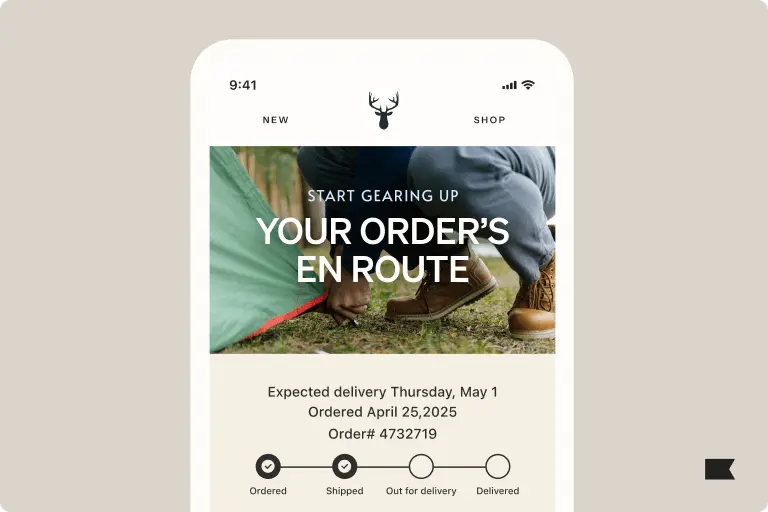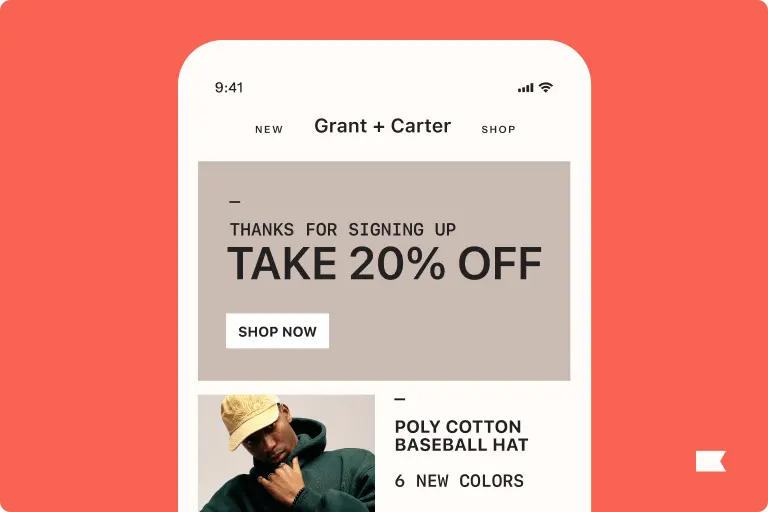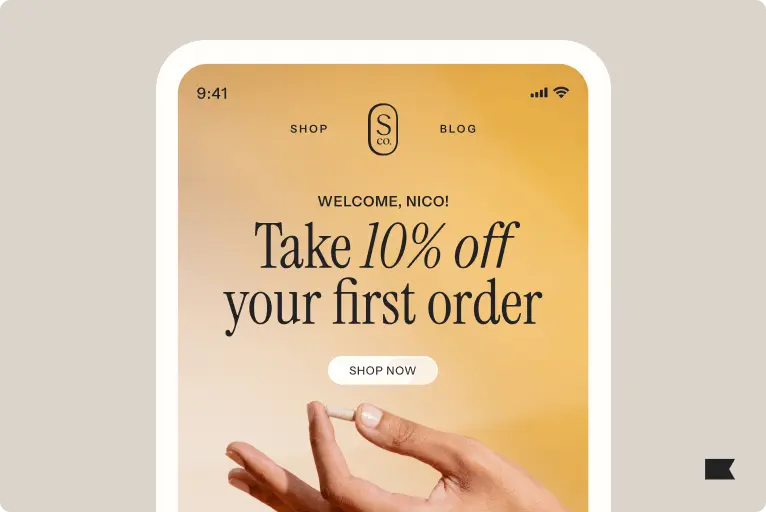9 email marketing strategy examples to boost engagement in 2025
Email marketing is one of the most powerful tools in your marketing toolkit—but only if you have a clear strategy behind it.
With more brands competing for inbox space and customer attention than ever before, your messages need to be part of a thoughtful strategy.
Today’s consumers expect personalized, timely, and relevant content—so now’s the time to get intentional. Whether you’re building your strategy from scratch or looking to refine what you already have, this guide walks you through some foundational tactics and real-world examples that can help make your email channel one of your most consistent revenue drivers.
What is an email marketing strategy?
An email marketing strategy is a structured approach to using email to engage customers, nurture relationships, and drive revenue. It involves planning, creating, and optimizing emails to ensure they align with business goals and audience needs—whether you want to welcome new subscribers, promote a product, recover abandoned carts, or re-engage inactive customers.
Without a strategy, email marketing lacks thoughtful intent. A strong plan helps you:
- Send the right message to the right people at the right time.
- Increase engagement and conversions through targeted, relevant content.
- Build long-term customer relationships with consistent, valuable communication.
- Maximize ROI by optimizing performance based on data-driven insights.
Your email marketing strategy and the tactics that go along with it make up the foundation of your owned channels. And it works: on average, email marketing generates $36 in revenue for every $1 spent, making it one of the most effective marketing channels available.
Creating an email marketing strategy can be done in just a few steps, but if you want to get into some nitty-gritty tactics with examples to back them up, you’re in the right place. With inspiration from real brands, we’ll show you how to:
- Use automation to generate consistent revenue.
- Combine email and SMS campaigns to generate more revenue.
- Create segments to increase engagement.
- Prioritize the mobile experience.
- Optimize all content elements with A/B testing.
- Focus on low-volume, high-impact flows.
- Leverage analytics to measure impact.
- Use predictive analytics to increase loyalty and reduce churn.
Email marketing strategies that work for B2C brands
For B2C brands, email marketing needs to be about more than sending blanket promotions. Now, with consumer expectations as high as they are, email marketing needs to deliver personalized, relevant content at scale to keep customers engaged and loyal.
Before we get into specific examples, here are some of the core components of email marketing that can help you eventually exceed expectations at every stage of the customer journey.
1. Personalization: delivering tailored brand experiences
Consumers now expect the emails they receive from brands to reflect their stated preferences and online behaviors. While personalization can start with a first name, this is no longer enough. Brands now need to be using permissions-based data to tailor their email marketing messages to people’s shifting preferences in real time.
But according to Klaviyo’s B2C CRM readiness quiz, only 12% of brands are creating personalized experiences across every touchpoint. Even fewer are using AI to create the kind of dynamic, personalized experiences that genuinely stand out, such as:
- Product recommendations based on browsing or purchase history
- Dynamic content that adapts based on real online interactions
- Location-based offers tailored to where someone lives
With zero- and first-party customer data, brands can create emails that feel relevant and timely, which increases engagement and conversions.
2. Segmentation: sending relevant messages at scale
A one-size-fits-all approach to email marketing can lead to low engagement and high unsubscribes. Segmentation is the antithesis of this approach. When you group customers with similar behaviors and traits, you can start to send more tailored messages at scale.
With segmentation, you can send targeted messages to specific customer groups based on:
- Past purchases and shopping behaviors
- Engagement levels (e.g., frequent shoppers vs. lapsed customers)
- Demographics or stated preferences
3. Automation: sending messages that reflect behaviors
Email automation is how marketers can make money in their sleep. Automated messages are sent when someone takes a certain action or meets certain criteria, such as subscribing to your email list or not interacting with your brand for a certain period of time.
Automations help brands send relevant messages to their customers at the right time without having to manually press “send.” Essential automated flows include:
- Welcome series emails to introduce new subscribers to your brand
- Cart abandonment emails to recover potential lost sales
- Re-engagement campaigns to win back inactive customers
By setting up these automated flows, brands can nurture customer relationships while maximizing revenue.
4. Mobile optimization: creating zero-friction experiences for subscribers
As more people shop and read email on their phones, mobile optimization for email is a must. Mobile optimization means writing and designing emails that are a pleasure to interact with on a mobile phone. Must-have components include:
- Responsive design for easy readability on any screen
- Subject lines that aren’t truncated on mobile screens
- Pre-header text that adds more context to subject lines
- Clear, tappable CTAs
9 email marketing strategy examples to guide you
We know the best email marketing strategies combine personalization, automation, segmentation, and mobile optimization—but what does that look like in action?
The following brands have successfully used their email marketing strategy to drive engagement, increase revenue, and build stronger customer relationships. From personalized product recommendations to well-timed re-engagement campaigns, these real-world examples showcase strategies that can help any B2C brand optimize its email marketing efforts.
1. Jordan Craig grows email revenue with AI-predicted date of next order
Men’s streetwear brand Jordan Craig has an email list of 1.5 million subscribers—making a one-size-fits-all email marketing strategy impossible. The data-driven brand wanted to make better use of the overwhelming amount of customer data they had, so their messages could better reflect their interactions with those subscribers.
By analyzing campaign performance by segment, Jordan Craig was able to uncover the ideal cadence for each of their 40+ audience segments. For instance, they now send daily emails to customers for two weeks before and after their AI-predicted date of next order, resulting in strong conversion rates.
These personalization strategies, among others, drove major gains—including a 54% YoY increase in email revenue within 6 months of their strategy and data infrastructure switch.
2. PangoBooks uses automated flows to retain more customers with personalized content
Secondhand book marketplace PangoBooks knows the power of retention marketing. When they convert sellers to buyers and buyers to sellers, they create more customers who are constantly refreshing their book collections.
“There’s a lot of lifetime value to be gained in this industry, with this marketplace,” says Dan Orkin, CMO at PangoBooks. “Being really focused on retention makes sense.”
PangoBooks got to work on overhauling their email marketing strategy with 20 new personalized email automations in under a year. For example, if a seller has listed fewer than 5 books, they get a flow advising them to list more; if they list over 5, they get tips on optimizing their listings and storefront.
“I can do things like define a segment of lapsed users that I want to re-motivate, send them a coupon code for $5 off their next purchase, and have dynamic content in the email that shows them book recommendations,” says Orkin.
Within the first 6 months of implementing their new flows, PangoBooks drove a 63% YoY increase in ecommerce revenue.
3. Fishwife boosts their omnichannel marketing strategy with their welcome flow and A/B testing
When fledgling seafood brand Fishwife appeared on Shark Tank, they knew they would need to prepare their email funnel for an influx of new subscribers. To maximize their appearance on the TV show, the brand refreshed their welcome flow to include:
- A plain-text note from CEO Becca Millstein, whom viewers knew from TV
- Product education for category newbies
- Last-chance messaging around their welcome discount
As the brand scaled, Fishwife A/B tested email layouts and experimented with different lengths, images, and button placements. For instance, Fishwife discovered that product launch emails perform best when they’re short, with in-depth details best left to product pages.
Fishwife’s story is a testament to how quickly growing brands can get up and running—and thriving—with the right tools in place. Their ability to scale and optimize their email marketing strategy has translated to real revenue growth across both email and SMS.
4. Dagne Dover prioritizes mobile with a punchy subject line
“Most email opens are happening on mobile devices, so it’s critical to think mobile-first when you’re writing subject lines,” says Dayna Scandone, principal customer success manager at Klaviyo.
“You should always be testing your email marketing campaigns on desktop and mobile to ensure they’re showing up exactly how you want them to,” Scandone adds. “That includes the subject line.”
You don’t necessarily need a super short subject line to see high email open rates. But at the very least, your subject line should look great on mobile.
Dagne Dover, the brand that creates “problem-solving bags for problem-solving humans,” demonstrates a mobile priority with this subject line that’s just 4 words long. It stands out in an inbox not only because it’s shorter than other emails, but also because it’s so concise and direct.
5. Laura Geller drives more profitability by combining high-volume email and SMS
Beauty brand Laura Geller is one of the 5 beauty brands in AS Beauty Group—and in total, those 5 brands once used 4 different email and SMS marketing platforms. The brand has since consolidated their data, which opened up new opportunities for testing both email volume and SMS volume.
In spring 2024, the brand ran a 30-day holdout test to evaluate the impact of a higher-volume messaging approach. They split customers into 4 cohorts that received:
- Full volume of email and SMS
- Full volume of email, 50% SMS volume
- Full volume of email, no SMS
- Full volume of SMS, no email
To their delight, they found that sending the full volume of email and SMS drove the best profitability and revenue results by far, across almost all of their 12+ customer segments.
“It’s given us confirmation that we are not scaring our customers away or costing ourselves from a profitability standpoint to have such high send volume,” says Katherine Cabe, senior director of retention at AS Beauty Group—though she hopes to do more testing on the strategy’s long-term effects.
6. Svenfish uses AI segments to send hyper-personalized emails, faster
Seafood brand Svenfish uses AI tools to send hyper-personalized campaigns that yield more revenue. Before, the brand would send one promotion out to their entire list—only to have people click through to a sold out product page. Now, they combine real-time customer data with AI to pair interactions with relevant offers.
For example, Svenfish uses AI to quickly build segments of customers who have shown interest in or bought whatever fish is fresh that morning—and send out targeted promotional campaigns that same day.
“Segments AI makes it so much easier to turn your thoughts into a basic segment skeleton you can work on,” says Sreevats R., product manager at Svenfish. “It saves a lot of time, because we don’t have to scroll through the tens of metrics we can use for segmentation to build it out.”
The team also uses predictive analytics to reward high-value customers whose forecasted customer lifetime value is above $200—which has helped them shrink their win-back segment and improve margins.
7. DKNY shifts to less frequent and more personalized email flows
Fashion brand DKNY had been sending general, frequent campaigns to their 1.2 million active subscribers, and “it felt like we oversaturated our list with messaging,” says Griffin Hawkinson, director of CRM and loyalty at DKNY.
The brand started by reducing the frequency of their email blasts, instead ramping up segmentation and investing in automations, like a price drop flow. They sent targeted promotions based on average order value (AOV), such as a bag sale for deal hunters who typically spend under $100—and further personalized these emails with dynamic product recommendations tailored to each subscriber, based on their past orders and how they were similar to other customers.
In just 3 months, this strategy reduced email volume by 24% YoY while boosting click rate 8% YoY.
8. New West KnifeWorks reactivates lapsed customers with RFM segmentation
“I’m a big fan of RFM modeling,” says George Rodríguez, founder and principal at A-Game Digital, New West Knifeworks’ digital agency. “This is something catalog brands were doing 50 years ago. It’s a proven methodology.”
RFM analysis is a way for businesses to categorize their customers by purchase recency, frequency, and monetary value. These 3 important metrics identify high-value customers and dormant customers, so brands can send tailored messaging that’s appropriate for each group.
Premium knife brand New West KnifeWorks used RFM analysis to reactivate dormant customers. Ahead of their National Knife Day sale, they emailed all their RFM segments, including infrequent customers who hadn’t bought in a long time—and as it turned out, 15% of total campaign revenue came from this segment.
On top of this immediate success, the brand also saw consistent engagement from this segment 6 months after their campaign launch. This proven email marketing strategy shows that even lapsed customers can be brought back into the fold with the right segmentation.
9. Cidercade more than doubles automation revenue with centralized data
A complete, unified view of your customers is essential for delivering personalized brand experiences. Brands that rely on fragmented data across multiple platforms often struggle to target the right customers with the right message at the right time. This lack of integration can lead to missed opportunities, wasted resources, and suboptimal engagement.
By integrating Klaviyo B2C CRM with their Square POS system, arcade bar Cidercade consolidated their email automations with customer data from their complex Square account, which spans 5 locations and multiple types of SKUs—memberships, in-person food orders, in-person ticket orders, online purchases, and more.
“Having that holistic view of a customer and seeing all of the touchpoints for one contact was critical for us,” says Joe Malone, CEO and co-founder of Cidercade. “You can’t get very smart and precise with the flows and campaigns if you don’t have a complete, clear picture of the customer.”
Now that the brand’s data all lives in one place, Cidercade is able to craft personalized email flows that drive a lot of engagement. For example, their win-back flows automatically trigger an offer for free admission when customers don’t visit for a few weeks—but only if the customer wins a rock, paper, scissors game against a staff member. This new flow contributed to a 221% increase in automation revenue over a period of 2 months.
Next steps: execute your email marketing strategy
With Klaviyo, the only CRM built for B2C, brands can collect and manage their customer data so they can easily execute their email marketing strategies. Use Klaviyo’s advanced web forms to gather customer data, 350+ integrations to unify that data in one place, and segmentation to send personalized messages to your subscribers and customers.
With Klaviyo B2C CRM, your email marketing strategy is more than a strategy—it’s part of an omnichannel experience that drives revenue and creates lasting relationships with your customers.



